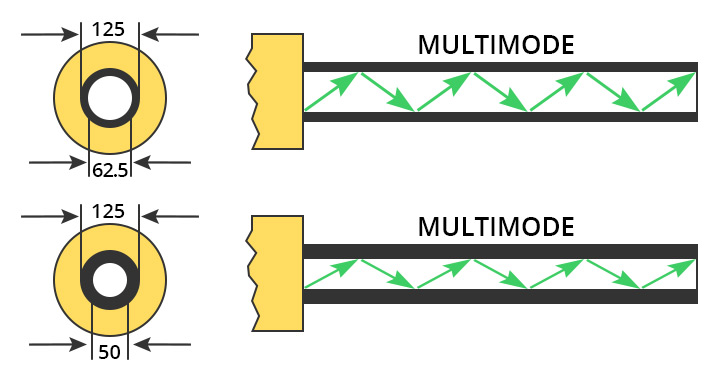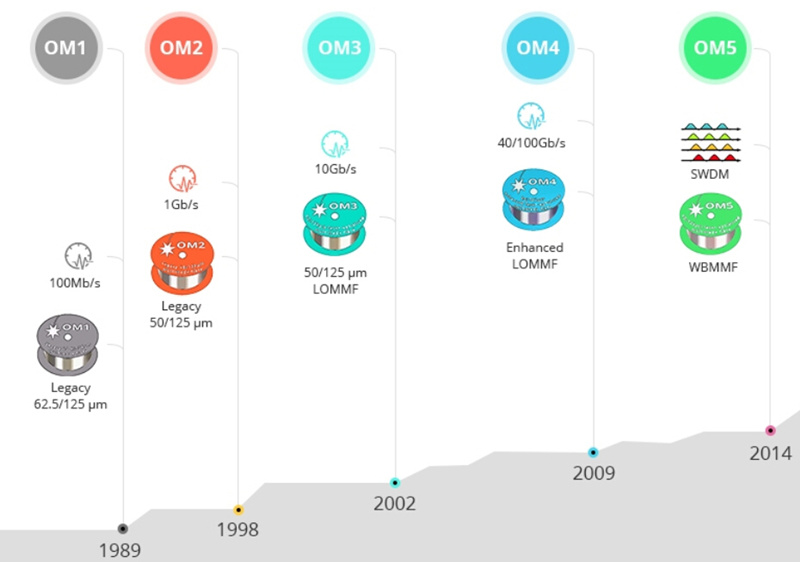Fiber Optic Tech
What is the Difference between OM1, OM2, OM3, OM4 and OM5 Multimode Fiber?
In integrated cabling, multimode fiber is mainly used for campus networks, LAN enterprise and data centers. There are several kinds of multimode fiber types available in the market include OM1, OM2, OM3, OM4, and OM5 with different data transmission capabilities. With so many types of multimode fiber, how to make a choice?

What Is Multimode Fiber?
Compared with single-mode fiber, multimode fiber has a larger core diameter, usually 50um or 62.5um, and supports multiple optical modes. Identified by ISO 11810 standard, multimode fibers are classified into OM1, OM2, OM3, OM4 and OM5.
OM1 multimode fiber uses LED light source, the core diameter is 62.5um, and the outer sheath is usually orange. It can be used for Ethernet below 10Gbps. It is most commonly used in 100M Ethernet. Due to the large core size, OM1 fiber has strong light-collecting ability and bending resistance.
OM2 multimode fiber uses LED light source with the core diameter of 50um, and the outer sheath is usually orange. It can be used for Ethernet below 10Gbps. Commonly used in 1 Gigabit Ethernet. Compared with the OM1 fiber, the core diameter of the OM2 fiber is smaller, which effectively reduces the modal dispersion of the multimode fiber, increases the bandwidth, and reduces the production cost.
OM3 multimode fiber is a laser-optimized multimode fiber. This type of fiber uses 850nm VCSEL laser light source with a core diameter of 50 um, and aqua outer sheath. It can be used for 10 Gigabit Ethernet. In the Gigabyte network, compared with OM1 and OM2 fibers, OM3 has higher transmission rate and bandwidth, so it is also called optimized multimode fiber or 10 Gigabit multimode fiber.
OM4 multimode fiber is an upgraded version of OM3 multimode fiber, and its performance is more superior. The effective bandwidth of OM4 fiber is more than double that of OM3 fiber, and it is compatible with OM3 fiber and shares the same aqua outer sheath. In 10Gbps Ethernet , OM4 fiber has a longer transmission distance than OM3 fiber, it can be up to 400 meters.
OM5 multimode fiber is a newest type wideband multimode fiber, compatible with OM4 fiber. Its core diameter is the same as OM2/OM3/OM4 fiber (50 um), and the outer sheath is lime green.
The main difference in multimode fiber is the physical difference. Therefore, physical differences result in different transmission data rates and distances.

Physical Difference
Physical differences are mainly in diameter, jacket color, light source and bandwidth.
|
MMF Cable Type |
Diameter |
Jacket Color |
Optical Source |
Bandwidth |
|
OM1 |
62.5/125um |
Orange |
LED |
200MHz*km |
|
OM2 |
50/125um |
Orange |
LED |
500MHz*km |
|
OM3 |
50/125um |
Aqua |
VSCEL |
2000MHz*km |
|
OM4 |
50/125um |
Aqua |
VSCEL |
4700MHz*km |
|
OM5 |
50/125um |
Lime Green |
VSCEL |
28000MHz*km |
Practical Difference
Multimode fiber can transmit different distance ranges at different data rates. You can choose the most suitable one according to your actual application.
|
MMF Category |
Fast Ethernet |
1GbE |
10GbE |
40GbE |
100GbE |
|
OM1 |
2000m |
275m |
33m |
/ |
/ |
|
OM2 |
2000m |
550m |
82m |
/ |
/ |
|
OM3 |
2000m |
/ |
300m |
100m |
70m |
|
OM4 |
2000m |
/ |
550m |
150m |
150m |
|
OM5 |
/ |
/ |
550m |
150m |
150m |
Development and Application
Under the demand of high-speed network applications, multimode fiber is developing towards low loss, high bandwidth and multi-wavelength multiplexing. With the continuous improvement of optical fiber technology, multimode optical fiber has developed from the original OM1 fiber to the OM5 fiber that supports 40/100G networks, and its performance is even better. OM1 and OM2 multimode fibers are used for 1G Ethernet link connections, and OM3 and OM4 multimode fibers are used for 10G/40G data center fiber cabling, and OM5 multimode fibers are suitable for 40/100G high-speed Ethernet link transmission. Compared with OM1/OM2/OM31OM4 multimode fiber, OM5 multimode fiber has high scalability and flexibility, it can support higher speed network transmission with fewer cores, and its cost and power consumption are much lower than that of single mode fiber. It can be seen that OM5 multimode fiber may be widely used in 100G/400G/1T ultra-large data centers in the future.



















